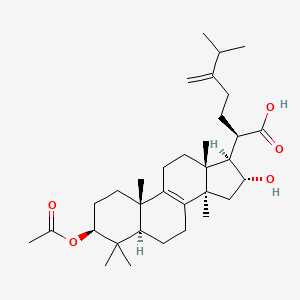Ferroptosis-centered Drug Response Information
General Information of the Drug (ID: ferrodrug0252)
| Name |
Pachymic acid
|
||||
|---|---|---|---|---|---|
| Synonyms |
Pachymic acid; 29070-92-6; 3-O-Acetyltumulosic acid; UNII-X2FCK16QAH; X2FCK16QAH; CCRIS 7792; Lanost-8-en-21-oic acid, 3-(acetyloxy)-16-hydroxy-24-methylene-, (3beta,16alpha)-; CHEMBL468034; CHEBI:80885; NSC 244427; NSC-244427; Pachymic-acid; HY-N0371; BDBM50292363; MFCD00238657; (3b,16a)-3-(Acetyloxy)-16-hydroxy-24-methylenelanost-8-en-21-oic acid; AKOS030526129; CS-5368; AC-33955; BS-42182; C17044; A912692; Q-100369; EBURICA-8,24(28)-DIEN-21-OIC ACID, 3.BETA.,16.ALPHA.-DIHYDROXY-, 3-ACETATE; LANOST-8-EN-21-OIC ACID, 3.BETA.,16.ALPHA.-DIHYDROXY-24-METHYLENE-, 3-ACETATE; LANOST-8-EN-21-OIC ACID, 3-(ACETYLOXY)-16-HYDROXY-24-METHYLENE-, (3.BETA.,16.ALPHA.)-
Click to Show/Hide
|
||||
| Structure |
 |
||||
| Formula |
C33H52O5
|
||||
| IUPAC Name |
(2R)-2-[(3S,5R,10S,13R,14R,16R,17R)-3-acetyloxy-16-hydroxy-4,4,10,13,14-pentamethyl-2,3,5,6,7,11,12,15,16,17-decahydro-1H-cyclopenta[a]phenanthren-17-yl]-6-methyl-5-methylideneheptanoic acid
|
||||
| Canonical SMILES |
CC(C)C(=C)CCC(C1C(CC2(C1(CCC3=C2CCC4C3(CCC(C4(C)C)OC(=O)C)C)C)C)O)C(=O)O
|
||||
| InChI |
InChI=1S/C33H52O5/c1-19(2)20(3)10-11-22(29(36)37)28-25(35)18-33(9)24-12-13-26-30(5,6)27(38-21(4)34)15-16-31(26,7)23(24)14-17-32(28,33)8/h19,22,25-28,35H,3,10-18H2,1-2,4-9H3,(H,36,37)/t22-,25-,26+,27+,28+,31-,32-,33+/m1/s1
|
||||
| InChIKey |
VDYCLYGKCGVBHN-DRCQUEPLSA-N
|
||||
| PubChem CID | |||||
Full List of Ferroptosis Target Related to This Drug
Nuclear factor erythroid 2-related factor 2 (NFE2L2)
| In total 1 item(s) under this Target | |||||
| Experiment 1 Reporting the Ferroptosis-centered Drug Act on This Target | [1] | ||||
| Target for Ferroptosis | Marker/Suppressor | ||||
| Responsed Disease | Acute kidney failure | ICD-11: GB60 | |||
| Pathway Response | Fatty acid metabolism | hsa01212 | |||
| Ferroptosis | hsa04216 | ||||
| Cell Process | Cell ferroptosis | ||||
| In Vitro Model | mKTs (Mouse knee tissues) | ||||
| In Vivo Model |
A total of 30 C57BL/6 male mice (8-10 weeks; 20-25 g body weight) were purchased from Chongqing Medical University (Chongqing, China). The mice were anesthetized with 50-60 mg/kg of pentobarbital sodium (cat. no. P3761; Sigma-Aldrich; Merck KGaA) by intraperitoneal injection; the skin at the surgical area was wiped with 70% alcohol. The incision was positioned at the left and right sides of the spine (0.5 cm), and the incision length was 1-1.5 cm along the back. The kidneys were subsequently pulled out from the incision to expose the renal pedicle. A microaneurysm clip was used to clamp the pedicle to block the blood flow to the kidney and induce renal ischemia. Complete ischemia was indicated by a change in the color of the kidney from red to dark purple within a few seconds. After 40 min of ischemia, the microaneurysm clips were released to allow each kidney to start reperfusion, which was indicated by the change of the kidney color to red.
Click to Show/Hide
|
||||
| Response regulation | Pachymic acid has a protective effect on ischemiareperfusion induced acute kidney injury in mice, which may be associated with the inhibition of ferroptosis in the kidneys through direct or indirect activation of NRF2, and upregulation of the expression of the downstream ferroptosis related proteins, GPX4, SLC7A11 and HO1. | ||||
